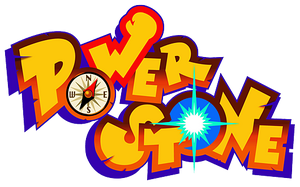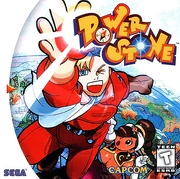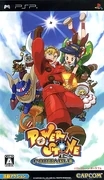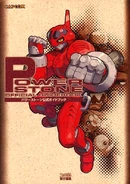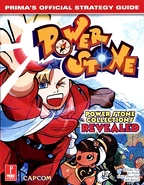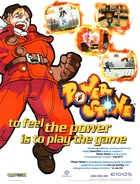Power Stone is a 3D arena fighting game developed and published by Capcom. The game revolves around several characters fighting for the magical "Power Stones", which are able to grant any wish. Power Stone was initially released on the Sega NAOMI hardware in 1999 and later ported to the Dreamcast. It is the first game in the Power Stone series.

DreamCast - Power Stone Intro (HD)
Promotional illustration for Power Stone and its sequel was handled by Bengus.
Gameplay[]
Gameplay involves selecting a character and then proceeding to battle the other characters, one at a time, in various locales. The fighting is three dimensional and includes the ability to use special attacks as well as pick up and fight with such objects as tables, chairs, rocks and bombs.
During battle, "Power Stones", resembling gems of different colors, appear in the arena. If a character collects three Power Stones, he/she transforms into a more powerful version of him/herself. The character will then be able to use one of two super special attacks. One is generally a massive long-range power attack and the other is a grab or close-range move.
The powered-up mode only lasts until the power bar is fully drained, during which the special attack can be executed (which completely depletes the power bar) or launch some form of projectile (which only uses a small portion of power). Each match continues until the life bar of one of the two characters fighting is depleted.
Characters[]
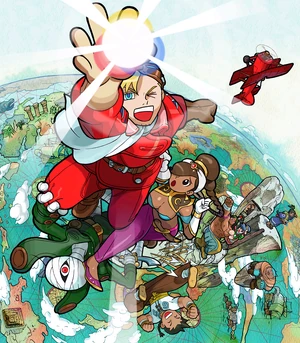
Promotional art.
| Fighters |
|---|
| Accel (Power Stone Collection only) |
| Ayame |
| Edward Falcon |
| Galuda |
| Gourmand (Power Stone Collection only) |
| Gunrock |
| Jack |
| Julia Whitepearl (Power Stone Collection only) |
| Kraken (secret character, boss) |
| Pete (Power Stone Collection only) |
| Rouge |
| Ryoma |
| Valgas (secret character, final boss) |
| Final Valgas (secret character, second from of Valgas) |
| Wang-Tang |
Reception[]
Blake Fischer reviewed the Dreamcast version of the game for Next Generation, rating it five stars out of five, and stated that "Every Dreamcast owner should have this title. It's unique, it's fast, and most importantly, it's loads of fun."[1]
The Dreamcast version of Power Stone received "favorable" reviews according to video game review aggregator GameRankings.[2] However, Power Stone Collection received "average" reviews according to video game review aggregator Metacritic.[3] In Japan, Famitsu gave the former console version a score of 34 out of 40.[4] In Europe, Computer and Video Games gave it a full 5-star rating, stating that "it's fantastic."[5]
Legacy[]
Power Stone 2[]
The game spawned a sequel, Power Stone 2, released in 2000.
Power Stone Collection[]
A compilation called Power Stone Collection (Power Stone Portable) was released in 2006 for the PlayStation Portable and includes a few enhancements. The original Power Stone now included the four new characters introduced in Power Stone 2 (Accel, Gourmand, Julia Whitepearl and Pete), while the sequel contained the two characters originally ommitted. Both games also contained new unique items.
The PSP game is available through a physical UMD and as a PlayStation Network download.
Anime[]
An anime show based on this game aired in 1999.
Manga[]
A lone Power Stone Manga from KC BomBom Comic was issued on 15 March 1999.[6] The anime is mostly based on this and the previewed graphics can be found in Dreamcast official site.[7]
Trivia[]
- It is interesting to note that there is a weapon to be obtained from Stone Man in Mega Man 5 called Power Stone. Whether or not Capcom named the game after this weapon is unknown.
- The logo of Power Stone logo appears as a billboard in Dead Rising 3's DLC mode Super Ultra Dead Rising 3' Arcade Remix Hyper Edition EX + α.
Credits[]
Director: Tatsuya Nakae, Hideaki Itsuno
Planner: Takeshi Shimono, Tomoaki Tsuji, Koji Shimizu
Programming: Yoshiyuki Ishikawa, Yukikaze Okagawa, Masakazu Matsushita, Hitoshi Yokota, Soji Seta, Motsu, Teruaki Hirokado, Kaw・Tld
Omake Game: Omake No1, Omake No2
Modeling Design: Masao Sakurai, Satomi Tsubota, Ban, S・Sakashita, Yuesuke, Takayuki Kosaka, Syuuhei, Yaccoys・Dekao, Huangcheng, Emiko Watanabe
Motion Design: Hidetoshi Kai, Shinya Kitamura, Tsunenori Shirahama, H.Tsuru, Naoki Fukushima, Masayuki Maeda 03, N.Fujisawa, Kako, Yoshiko Tanida, Yoko Yamane
Stage Design: Shinya Kuwajima!!, Takashi Fujiwara, Saru, Goro Suzuki 1998, Kouji Yamamoto, Kenji Kushiro, Akio Kamiji
Effect Design: Daisuke,, Yoshio, Koji・Sugimine
Music Composer: Tetsuya Shibata
Sound Engineer: Wataru Hachisako, Hiroshi Ohno
Mixing Engineer: Kazuya Takimoto
Character Design: Akiman, Hideki
Original Artwork: Wsu
Title Logo Design: Shoei
Instruction Card: Sakomizu, Togatti
Voice Actor: Sayaka Aida, Takeshi Aono, Yousuke Akimoto, Jurouta Kosugi, Masashi Sugawara, Wataru Takagi, Atsushi Tanaka, Hikari Tachibana, Sakiko Tamagawa, Ryo Horikawa
Special Thanks: Shin., Tom Shiraiwa, Manatie, H.Watanabe, Steve Lee, Mikky, Erik Suzuki, Dan Okada, Chris Tang, Hiroshi Terada
Producer: Takeshi Tezuka
General Producer: Noritaka Funamizu
Executive Producer: Yoshiki Okamoto
And: All Capcom Staff
Presented by: Capcom
Gallery[]
Box art[]
Merchandise and advertisements[]
References[]
- ↑ cite magazine|last=Fischer|first=Blake|title=Finals|magazine=Next Generation|volume=2|issue=1|publisher=Imagine Media|date=September 1999|pages=82–83
- ↑ http://www.gamerankings.com/dreamcast/198332-power-stone/index.html
- ↑ http://www.metacritic.com/game/psp/power-stone-collection
- ↑ cite journal|title=ドリームキャスト - パワーストーン |magazine=Famitsu |volume=915 |date=30 June 2006 |page=34
- ↑ https://archive.org/stream/Computer_and_Video_Games_Issue_215_1999-10_EMAP_Images_GB#page/n65/mode/2up
- ↑ http://www.goodcowfilms.com/farm/games/news-archive/PowerStone%20Comic%20And%20Cartoon%20Information.htm
- ↑ https://web.archive.org/web/20100914102236/http://www.capcom.co.jp/newproducts/consumer/powerstone/ps1/index.html

